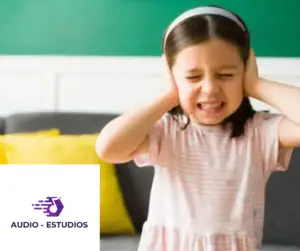Noise and sound are all around us, but have you ever stopped to think about the differences between them? Some think they are the same, but of truth, they are quite different. So, here on this page, you will get to learn the difference between sound and noise.
Noise is an unwanted or unpleasant sound, while a sound is a type of energy that travels through the air and can be heard when it reaches a person’s ear. Noise can be distracting and disruptive, while sound can be enjoyable and even therapeutic.
Knowing the difference between sound and noise is important for a few reasons. So, understanding the perceived quality of sound and noise can help you to appreciate the role that sound plays in your life and the ways in which it can be enjoyable and beneficial.
What is noise?
Noise is unwanted or unpleasant sound. It is often described as loud or jarring and can be distracting or disruptive. Noise can also have various qualities, such as pitch and volume, but is generally considered to be less pleasant than sound.
Also, noise can come from a variety of sources, including traffic, construction, appliances, and other sources of loud or disruptive sound. In general, noise is an unwanted or unpleasant sound that can be disruptive or distracting.
What is sound?
Sound is a type of energy that travels through the air and can be heard when it reaches a person’s ear. It is typically described as pleasant or enjoyable and can have a variety of different qualities, such as pitch, volume, and timbre.
Also, the sound is produced when something vibrates, causing the air around it to move and create pressure waves that can be heard by the human ear. Sound can come from a wide range of sources, including music, speech, and natural phenomena.
What are the effects of noise?
The effects of noise can vary depending on the specific situation and the level of noise. In general, noise can have a range of negative effects on the human body and mind, such as:
1. Hearing loss: Exposure to loud noise can damage the sensitive hair cells in the inner ear, leading to hearing loss over time.
2. Stress and anxiety: Noise can be stressful and can cause anxiety, particularly if it is loud or disruptive.
3. Sleep disturbance: Noise can interfere with sleep, making it difficult to fall asleep or stay asleep. This can lead to fatigue and other negative health effects.
4. Heart disease: Exposure to loud noise over long periods of time has been linked to an increased risk of heart diseases, such as high blood pressure and heart attacks.
5. Cognitive effects: Noise can also have negative effects on cognitive function, such as reducing attention span and impairing memory.
These are just a few examples of the effects of noise. Noise can also have other negative effects, depending on the specific situation and the level of noise. It’s important to recognize and reduce unwanted noise in order to protect your health and well-being.
How is sound measured?
Sound is typically measured in units called decibels (dB). The decibel scale is a logarithmic scale that measures the intensity of sound, with a lower decibel level indicating a quieter sound and a higher decibel level indicating a louder sound.
The decibel scale is relative, meaning that the reference point for 0 dB varies depending on the type of sound being measured. For example, the threshold of human hearing is generally considered to be 0 dB, while the threshold of pain is around 120 dB.
What are the Two Types of Sound?
There are two main types of sound: simple sound and complex sound.
Simple sound
Simple sound is a type of sound that consists of a single frequency or pitch. This type of sound is often referred to as a pure tone or a sine wave. Simple sound is produced when a single, undisturbed source of vibration, such as a tuning fork, creates a regular and predictable pattern of pressure waves in the air.
These pressure waves travel through the air and can be heard when they reach a person’s ear. The pitch of a simple sound is determined by the frequency of the pressure waves, with higher frequencies producing higher pitches and lower frequencies producing lower pitches. Examples of simple sounds include the sound of a tuning fork or a pure musical note from a synthesizer.
Complex sound
Complex sound, on the other hand, is a type of sound that consists of multiple frequencies or pitches. This type of sound is often referred to as a composite wave or a compound tone.
Also, complex sound is produced when multiple sources of vibration, such as the strings of a guitar or the vocal cords of a person speaking, create overlapping and interfering pressure waves in the air.
These pressure waves travel through the air and can be heard when they reach a person’s ear. The pitch of a complex sound is determined by the combination of frequencies in the pressure waves, with some frequencies being more dominant than others. Examples of complex sounds include speech, music, and environmental sounds.
Generally, a simple sound is characterized by a single frequency, while a complex sound is characterized by multiple frequencies. Both types of sound are important for human communication and enjoyment, but they have different properties and characteristics.
Difference between sound and noise
The main difference between sound and noise is their perceived quality. Sound is a type of energy that travels through the air and can be heard when it reaches a person’s ear. It is typically described as pleasant or enjoyable and can have a variety of different qualities, such as pitch, volume, and timbre.
In contrast, noise is unwanted or unpleasant sounds. It is often described as loud or jarring and can be distracting or disruptive. Noise can also have various qualities, such as pitch and volume, but is generally considered to be less pleasant than sound.
Here are some of the main differences between sound and noise:
1. Perceived quality: Sound is typically perceived as pleasant or enjoyable, while noise is often perceived as unpleasant or disruptive.
2. Characteristics: Sound has a variety of different characteristics, such as pitch, volume, and timbre, while noise may also have these characteristics but is generally considered to be less pleasant than sound.
3. Purpose: Sound is often produced intentionally, for example, in music or speech, while noise is typically considered to be unwanted or unintentional.
4. Effects: Sound can have positive effects on the human body, such as relaxation or stress relief, while noise can have negative effects, such as hearing loss or increased stress levels.
5. Control: Sound can be controlled to some extent, for example, by using soundproofing or noise-canceling technology, while noise is generally more difficult to control.
These are just a few examples of the differences between sound and noise. There may be other differences depending on the specific situation and context.
Pros and cons of noise and sound
Here are some pros and cons of noise and sound:
Pros of noise
- Noise can serve as a warning or alarm, alerting people to potential danger or emergency situations.
- Noise can also be used as a deterrent, for example, to keep animals away from crops or to discourage loitering in a public space.
- In some cases, noise can be used as a communication tool, such as in certain types of military or emergency communication systems.
Cons of noise
- Noise can be disruptive and distracting, making it difficult for people to concentrate or communicate.
- Noise can also be stressful, causing increased levels of anxiety and other negative mental health effects.
- Over time, exposure to loud noise can lead to hearing loss and other negative health effects.
Pros of sound
- Sound can be enjoyable and pleasurable, providing enjoyment and relaxation through activities such as listening to music or enjoying nature.
- Sound can also be used as a therapeutic tool, for example, in music therapy or sound meditation.
- Sound can be an important tool for communication, allowing people to share ideas and information through speech and other forms of communication.
Cons of sound
- In some cases, sound can be too loud or disruptive, leading to negative effects such as hearing loss or stress.
- Sound can also be used as a weapon, for example, in sonic warfare or crowd control.
- In some situations, sound can be difficult to control or contain, leading to noise pollution and other negative effects.
Conclusion
Sound and noise are two types of energy that can be heard by the human ear. Sound is typically perceived as pleasant or enjoyable and can have a variety of different characteristics, such as pitch, volume, and timbre.
In contrast, noise is unwanted or unpleasant sound that is often described as loud or jarring. Noise can also have various characteristics but is generally considered to be less pleasant than sound.
It’s important to understand the difference between sound and noise and to appreciate the role that sound plays in our lives. By recognizing and reducing unwanted noise, we can protect our health and well-being and enjoy the benefits of sound.




